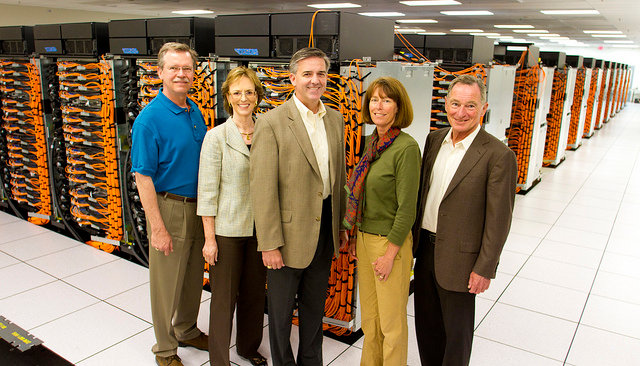
IBM Sequoia (photo ©ibmphoto24) supercomputer has been crowned at the top of the list of the 500 most powerful supercomputers in the world. For the first time since November 2009, this record is held by an American computer after an Asian reign in China and especially Japan.
The Sequoia supercomputer is based on the Blue Gene/Q architecture, the latest version of the architecture developed by IBM exactly to build supercomputers. Sequoia uses Power BQC processors with 16 cores clocked at 1.6 GHz stacked in 96 racks. The total number of cores is 1,572,864 for a total computing capacity of 16,324.8 TeraFlops. It has 1,572,864 GBytes (nearly 1.6 PetaBytes) of memory.
To have a comparison, the previous holder of the title of world’s most powerful supercomputer, the Japanese K, is equipped with SPARC64 VIIIfx at 2.0 GHz processors for a total of 705,024 cores and has a total computing capacity of 10,510 TeraFlops.
The Sequoia supercomputer was installed at the Lawrence Livermore National Laboratory, a research center funded primarily by the U.S. Department of Energy. It will be used primarily to simulate nuclear explosions with a precision never seen before. Luckily, it will also be used for scientific purposes in various fields, from astronomy to biology but also to study climate changes.
[ad name=”AmazonElectronics468″]
The activation of the Sequoia supercomputer crowns about three years of work. In 2009, a smaller prototype called Dawn was built based on the Blue Gene/P architecture and with its 500 TeraFlops in June 2009 reached the ninth place in the ranking of the 500 most powerful supercomputers in the world.
As its operating system, the Sequoia supercomputer uses Linux, like the vast majority of the 500 most powerful supercomputers in the world. Compute Node Linux runs on almost 98,000 nodes with Red Hat Enterprise Linux running on 768 I/O nodes connected to the Lustre file system.
The cooling system of the supercomputer Sequoia uses water, which flows through thin copper tubes which encircle each card containing a node. For this reason, the 7m890 KWatts of power consumed at full operation are much less than they look. In fact, the K supercomputer consumes 12.659 KWatts.
Increasingly powerful supercomputers are built all the time and the existing ones are sometimes upgraded to make incredibly complex simulations. We shall see how long Sequoia will remain the most powerful.

